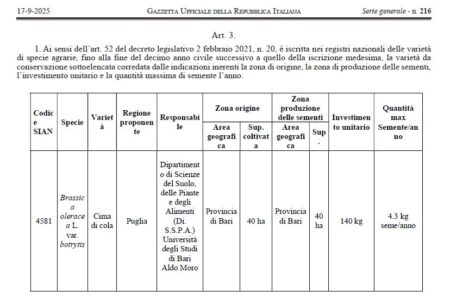- A little more safety for Ukraine’s seeds, thanks to a new genebank.
- A little more safety for Mexico’s native maize, thanks to Pres. Sheinbaum.
- A little more safety for Andean agriculture, thanks to Ecuadorian Indigenous women and Inside Mater in Peru.
- A little more safety for Ischia’s zampognaro bean and Amalfi’s lemons, thanks to local people (and GIAHS).
- A little more safety for Pacific crops, thanks to cryopreservation. Breadfruit next?
- A little more safety for moringa? At least in Africa with all its “opportunity crops”?
Nibbles: Fiona Hay, Richard Ellis, FAO exhibition, Peasants, Wheat breeding, Svalbard, Søren Ejlersen, Ephraim Bull, Heirloom apples, Caffeine, Collards history
- Dr Fiona Hay, seed scientist, on why we need genebanks, including seed banks.
- Prof. Richard Ellis retires. A genebank legend, as Fiona would probably agree.
- FAO exhibition goes From Seeds to Foods. By way of genebanks, no doubt.
- And peasants, of course. No, it’s not a derogatory word, settle down.
- Can Green Revolution breeding approaches (and genebanks) help peasants deal with climate change?
- Even genebanks need a back-up plan though.
- New Mexico genebank helps out Danish chef.
- The history of the Concord grape and its foxiness. Chefs intrigued.
- The history of Aport and Amasya apples. No foxiness involved, as far as I know. Genebanks? Probably.
- The origin of caffeine. Now do foxiness.
- Where did collards come from anyway? No, not genebanks. Bloody historians, always re-writing history.
Brainfood: Breeding edition
- Unlocking the potential of wild rice to bring missing nutrition to elite grains. A solution for better nutrition.
- Characterization of Oryza glaberrima derived genetic resources for stagnant flooding tolerance in interspecific rice pre-breeding populations. A solution for too much water.
- Strengthening Global Rice Germplasm Sharing: Insights from the INGER Platform. A solution for getting the above solutions out to those who need them.
- Comprehensive nutritional and antinutritional characterization of pigeonpea (Cajanus cajan): Insights into genotypic diversity and protein quality. A solution for better protein.
- Exploring the agro-morphological performance of mini core collection of finger millet [Eleusine coracana (L.) Gaertn] germplasm under sodic condition. A solution for high sodium in soils.
- A Public Private Partnership in Plant Breeding — The Case of Irish Malting Barley. A solution for Irish malt.
- The business case for grasspea in Ethiopia: An action plan to provide Ethiopian farmers with a safe, nutritious and climate-smart protein source. A solution for ODAP. Which will still need to be sold, though.
- Harnessing historical genebank data to accelerate pea breeding. A solution for cold, and more.
- Genetic basis of phenotypic diversity in C. stenophylla: a stepping stone for climate-adapted coffee cultivar development. A solution for heat.
- A phylogenetic approach to prioritising crop wild relatives in Brassiceae (Brassicaceae) for breeding applications. A solution for finding solutions.
‘Cima di cola’ reaches a milestone, apparently
So it seems the first vegetable variety from Puglia has been added to Italy’s Registro nazionale delle varietà da conservazione, or National Register of Conservation Varieties.
The ‘Cima di cola’, a cauliflower variety historically linked to the agricultural tradition of Bari, received official recognition by Ministerial Decree of 9 September 2025, published in the Official Gazette No. 216 of 17 September 2025, which will allow its conservation and promotion also at the commercial level.
I know this because of a post on Facebook from an outfit called Biodiversità delle specie orticole della Puglia (BiodiverSO), translated above. Which unfortunately doesn’t include a link, but does provide this screenshot of Italy’s Official Gazette to prove its point.
Here’s more from the BiodiverSO post.
The inclusion of the ‘Cima di cola’ among conservation varieties is not only an institutional achievement, but also an act of recognition toward those who have preserved its seeds and traditions over the years; a milestone that opens new opportunities for scientific, educational, and gastronomic promotion, which we look forward to sharing with you.
Doubtless.
Which is why I was pretty disappointed to find that the Registro nazionale delle varietà di specie agrarie ed ortive is not actually up to date, so doesn’t yet include ‘Cima di cola’.
Quite apart from not being exactly easy to find. And there was also nothing in the relevant news section, which is actually on a different website, but nevermind.
Anyway, there are 135 “Varietà da Conservazione” registered therein. It’s unclear how to obtain seeds.
LATER: Thanks to Filippo Guzzon for advising me that ‘Cima di cola’ is indeed on the list. I was looking for it under the wrong crop name :(
Nibbles: Ancient Mexican seedbank, Indian millets, Foraged foods, Soybean breeding, Apple breeding, Albanian heirlooms, Bangladesh fish genebank
- People in the Nejapan Sierra Sur in Oaxaca, Mexico had a seed bank 400-700 years ago so they could re-create their complex cuisine after disruptions.
- How MSSRF revived millets in Odisha, India. You think a seed bank was involved?
- Meanwhile, in Meghalaya (also India), foraged foods are helping to diversify state-provided school lunches and address chronic malnutrition. Talk about complex cuisine. Are all these species in a seed bank somewhere, though? Do they need to be?
- How the National Soybean Germplasm Collection at the Agricultural Research Service lab in Urbana, Illinois helped save soybeans in Iowa.
- University breeding programmes are keeping the apple afloat in the USA. That and genebanks.
- Farmers and agrotourism are bringing back some cool flavors in Albania. Well, that and the Albanian Gene Bank.
- Fish need genebanks too, and Bangladesh is on it. Did ancient Bangladeshis have them, I wonder?

